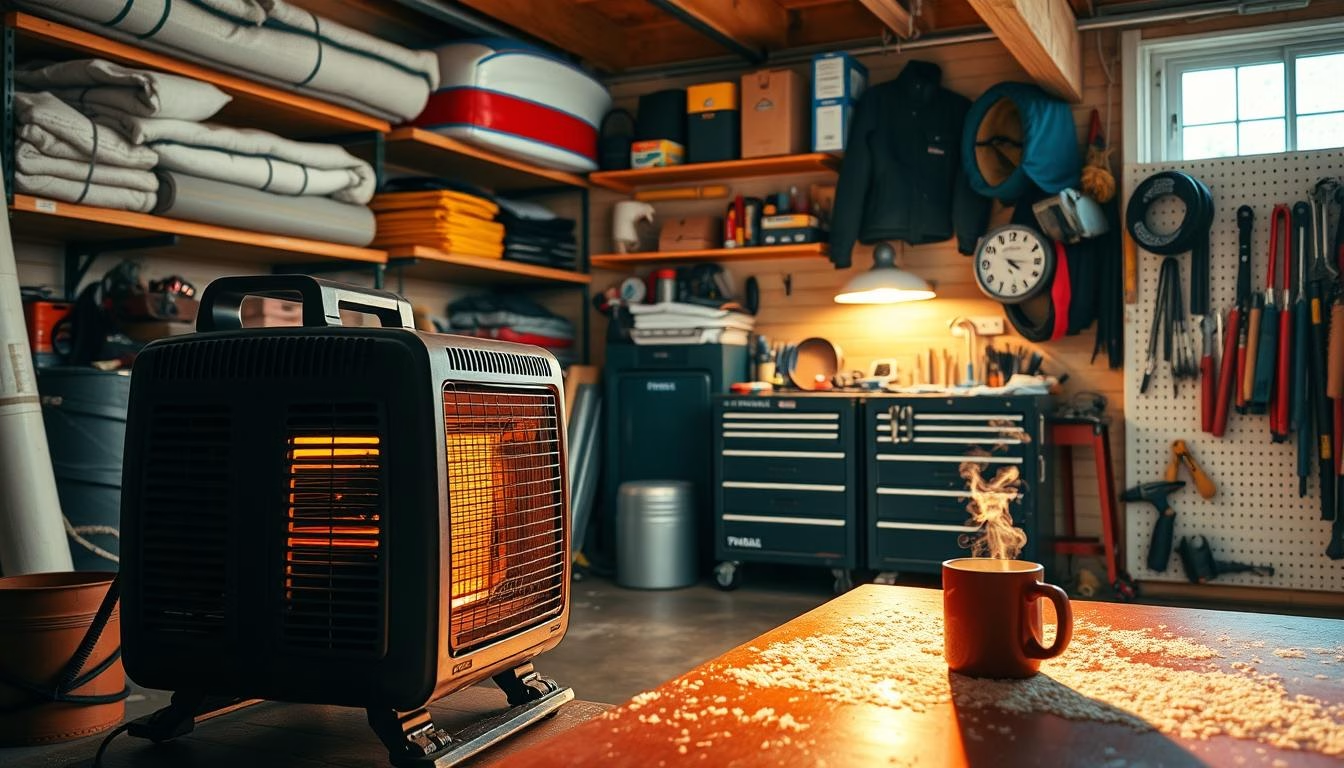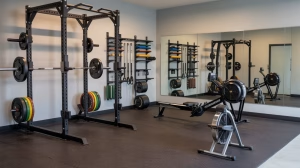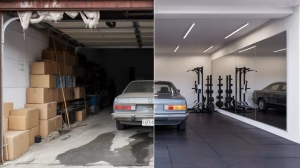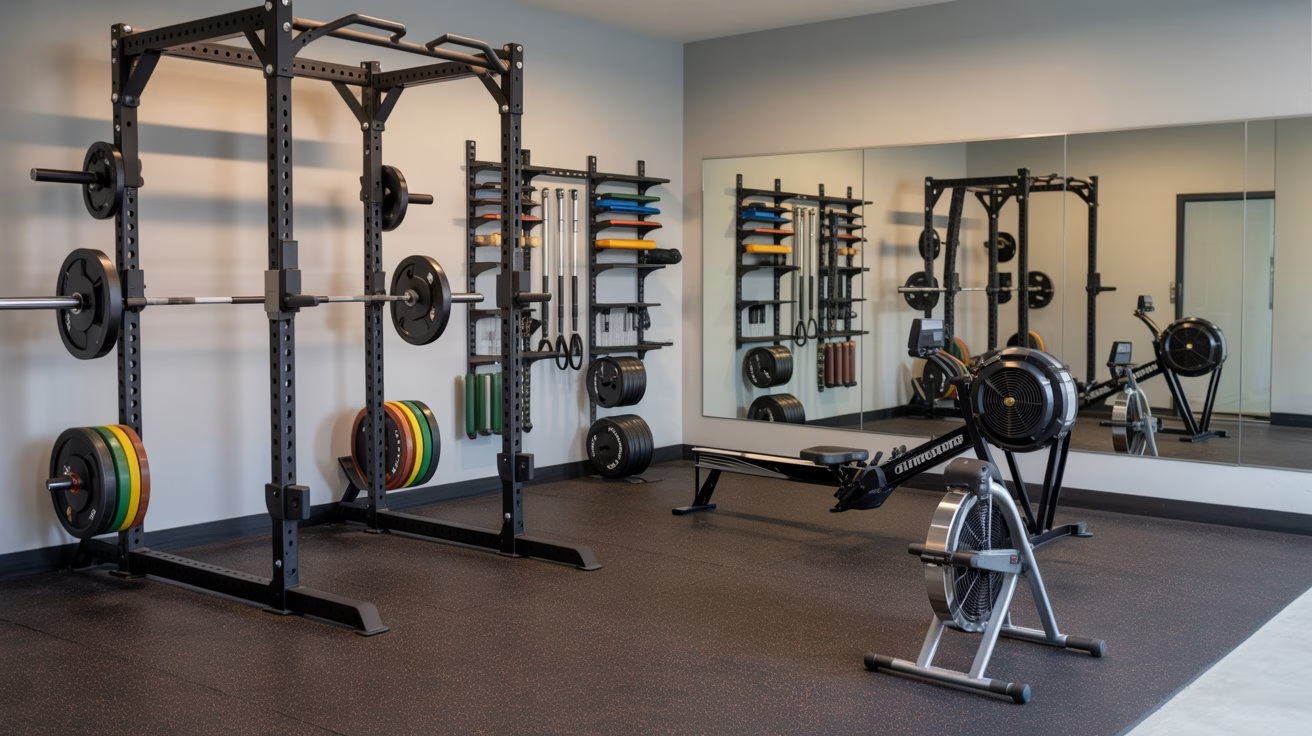As winter sets in, keeping your garage warm is crucial for home maintenance. Proper winter weatherproofing of your garage ensures comfort and protects your vehicles, tools, and equipment from cold temperatures. It’s vital to understand how to maintain a warm garage during winter. This prevents water hoses from freezing and cracking, vehicle fuels from gelling, and excessive energy use by water heaters without insulation.
Keeping your garage warm can also save on fuel by reducing the time it takes to warm up your car. Additionally, a warm garage offers a safe and cozy space for pets during the cold months. Adopting efficient heating methods and insulation techniques is key to a warm and functional garage all winter.
Key Takeaways
- Proper garage winter weatherproofing ensures comfortable and safe spaces.
- Warm garages prevent freezing and cracking of water hoses.
- Efficient heating methods reduce fuel waste and energy consumption.
- A warm garage maintains the functionality of tools and equipment.
- Pets can safely stay in a well-heated garage during winter.
Understanding Garage Insulation Basics
Insulating your garage for winter is crucial for a warmer environment, better energy efficiency, and structural integrity. Proper insulation significantly reduces heat loss, ensuring a comfortable temperature during the cold months. We delve into the importance of insulation and the various options for garages.
Why Insulation Matters
Insulation acts as a heat barrier, crucial in winter when temperatures plummet. It not only retains heat but also cuts down on energy use, lowering heating costs. Moreover, it safeguards vehicles and stored items from freezing damage.
Types of Insulation for Garages
Several insulation options can enhance your garage’s warmth and energy efficiency. The most prevalent include:
| Type of Insulation | Description | Pros | Cons |
|---|---|---|---|
| Fiberglass Batt Insulation | Composed of fine glass fibers, fits between studs and joists. | Cost-effective, easy to install, widely available. | Can be itchy to handle, prone to moisture damage. |
| Spray Foam Insulation | A liquid foam that expands and hardens, providing a tight seal. | High R-value, seals gaps effectively, enhances structural strength. | More expensive, professional installation recommended. |
| Foam Board Insulation | Rigid panels for walls, ceilings, and floors. | High insulating value per inch, moisture-resistant. | Installation can be challenging, higher initial cost. |
| Reflective Barriers | Thin sheets with a reflective surface that reflects radiant heat. | Lightweight, easy to install, reduces heat transfer by radiation. | Less effective in colder climates, often used with other insulation types. |
Benefits of a Warm Garage
As winter approaches, a warm garage is more than a luxury; it’s a necessity. The right heating methods can turn it into a protective space for your vehicles and equipment. This makes winterizing your garage a critical task.
Protecting Your Vehicles
Keeping your garage warm is crucial for your vehicles. Cold weather can cause fuel to gel, straining your car’s engine. A warm garage ensures smoother starts and lessens the risk of engine damage. It also prevents fluids from freezing, a common problem in winter.
Maintaining Tools and Equipment
A heated garage also safeguards your tools and equipment. Water freezing in hoses or tools can cause significant damage. By keeping your garage warm, you can extend your tools’ lifespan and cut down on maintenance costs. Winterizing your garage is a smart move to protect your investments.
Finding the right temperature balance is essential for these benefits. Here’s a comparison of heating methods to find the best for your garage:
| Heating Option | Benefits | Drawbacks |
|---|---|---|
| Electric Heaters | Safe and easy to install | Higher electricity bills |
| Gas Heaters | Efficient and cost-effective | Requires ventilation |
| Propane Heaters | Portable and efficient | Fuel costs can add up |
Essential Heating Options for Garages
Choosing the right heating for your garage depends on its specific needs and layout. Various heating solutions can turn your garage into a cozy space, even in the chilliest months. Here are some top options to consider:
Electric Heaters: A Safe Choice
Electric heaters are perfect for garages used occasionally. They provide enough heat without the need for complex installations. However, their operational costs can rise due to electricity prices. They come in styles like wall-mounted and portable, offering flexibility.
Gas Heaters: Pros and Cons
Gas heaters connected to your home’s natural gas supply offer quick warmth. They are powerful and can heat up your garage fast. Yet, it’s crucial to ensure proper ventilation to avoid carbon monoxide risks. Correctly installed ventilation systems are essential for safe operation.
Propane Heaters: Portable Heating Solutions
Propane heaters are great for garages without access to natural gas. They are mobile and can be placed where heat is most needed. Remember, propane tanks need regular maintenance to ensure continuous heating. Their portability and versatility make them a popular choice for many garages.
DIY Garage Insulation Techniques
Implementing effective DIY garage insulation techniques can significantly enhance the warmth and comfort of your garage during winter. This section covers practical tips for sealing gaps and adding insulation to garage doors.
Sealing Gaps and Cracks
Sealing gaps and cracks is a key DIY garage insulation technique. Begin by inspecting the areas around windows, doors, and the foundation. Use weather stripping and caulk to seal any openings. These materials are cost-effective and prevent cold drafts from entering your garage.
Adding Insulation to Doors
Adding insulation to your garage doors is crucial for maintaining comfort. You can use kits designed for garage doors or standalone materials like foam boards. Make sure the insulation covers the entire door surface to reduce heat loss. This method is one of the most practical for keeping your garage warm and boosts energy efficiency.
Using a Radiant Floor Heating System
Radiant floor heating systems are a top choice for keeping garages warm and cozy during winter. They distribute heat evenly, boosting comfort and efficiency. We’ll delve into the benefits and installation tips for these systems.
Advantages of Radiant Heating
One major plus of radiant floor heating is its ability to heat the garage floor uniformly. Unlike traditional heating, which can leave cold spots, radiant heating warms every area. These systems also run quietly and don’t stir up dust, perfect for those with allergies and who value a clean space.
Installation Considerations
Installing radiant floor heating involves placing heating elements under the garage floor. This can happen during construction or major renovations. It’s crucial to hire experts to ensure the system is set up right, for optimal performance and life span. Considerations include the flooring material, insulation quality, and how it might work with your current heating setup.
Keeping the Garage Door Insulated
Insulating your garage door is crucial for a warm and energy-efficient space during winter. Insulated garage door kits are a top choice for this purpose. They fit standard doors and greatly reduce heat loss.

Insulated Garage Door Options
Homeowners have several options for insulating their garage doors. Insulated kits, including foam or reflective materials, are highly effective. They help keep your garage warm and cut down on energy use.
Draft Stoppers for Garage Doors
Draft stoppers are essential for sealing gaps and keeping cold air out. They fit along the door’s bottom edge and can be adjusted. This simple addition significantly improves your garage’s warmth and energy efficiency.
Smart Thermostats for Your Garage
Smart garage thermostats can greatly improve your garage’s temperature management. These devices optimize energy use and maintain your preferred temperature with accuracy.
Benefits of a Smart Thermostat
Smart thermostats offer numerous advantages for your garage. They provide exact temperature control, adjusting to your habits and preferences. This results in significant energy savings, as they reduce heating when not required. Moreover, remote control via a smartphone app lets you adjust settings from anywhere. This ensures your garage is perfectly warmed up before you arrive.
How to Program Your Thermostat
Mastering your garage thermostat’s programming can lead to enhanced energy efficiency and cost savings. Begin by analyzing your garage’s usage patterns—entry times, stay durations, and weather conditions. Most smart thermostats enable scheduling, allowing you to program heating to lower when unused and warm up before your arrival.
- Access the thermostat’s programming menu, usually via the accompanying app or the device itself.
- Set your weekday and weekend schedules according to your typical garage use.
- Adjust temperature settings according to your comfort preferences and the time of day.
- Utilize the thermostat’s learning mode, if available, which automatically adjusts based on your past behavior patterns.
Adopting a smart garage thermostat not only ensures comfort but also leads to long-term energy bill savings. Whether for projects, storing valuables, or daily use, this advanced device guarantees a consistently cozy environment.
Best Practices for Garage Heating
Efficient garage heating practices ensure warmth and comfort during winter. Strategic heater placement and regular maintenance are key. They help create an optimal heating environment in your garage.
Strategic Heater Placement
Proper heater placement boosts heating efficiency. Place heaters near workbenches or the entrance, where you spend most time. This ensures even heat distribution and targets the most used areas.
Avoid heaters near flammable materials or where airflow is blocked. This can reduce efficiency and pose safety risks.
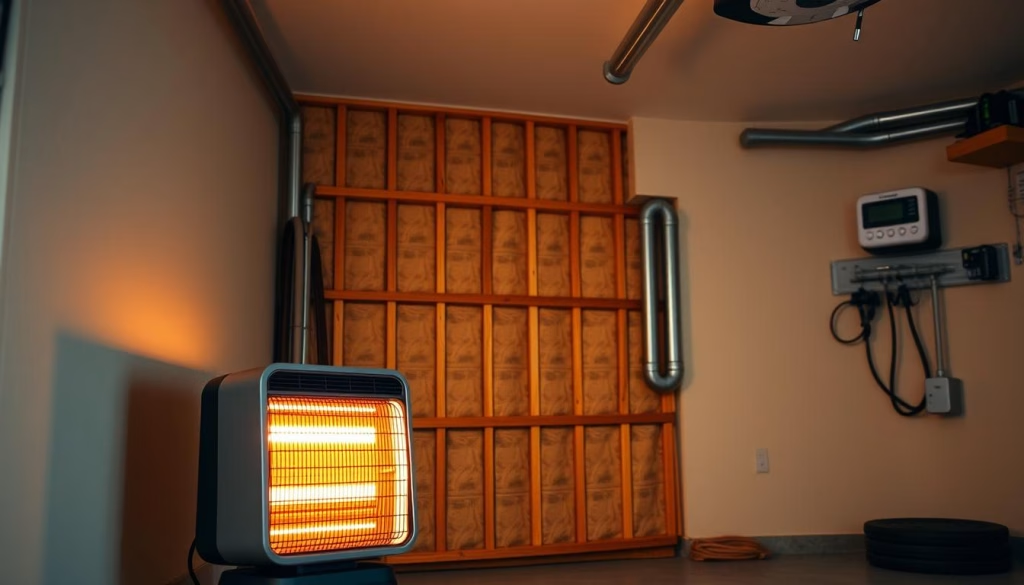
Using a mix of ceiling-mounted and wall-mounted heaters is beneficial. They optimize space usage and distribute heat effectively.
Regular Maintenance Tips
Maintaining garage heaters is vital for performance and safety. Regular inspections and services prevent hazards and ensure efficiency. Key tasks include cleaning filters, checking for leaks, and ensuring electrical connections are secure.
- Inspect and clean filters monthly to prevent dust accumulation and maintain airflow.
- Check for any gas leaks or blockages if you use a gas heater.
- Ensure electrical connections are tight and free from corrosion.
- Schedule an annual professional servicing to address any complex issues and keep your heater in top shape.
Following these efficient garage heating practices and maintaining your heaters ensures a warm garage all winter.
Additional Tips for Retaining Heat
As winter draws near, it’s vital to ensure your garage stays warm and functional. There are ways beyond traditional heating to keep your garage cozy. Homeowners can take steps to boost the warmth of their garage.
Using Heavy Curtains
Heavy curtains are a smart choice for keeping your garage warm. They add an extra layer of insulation, cutting down on heat loss and drafts. Opt for thermal or blackout curtains for even better insulation.
Creating Air Barriers
To keep your garage warm, focus on creating garage air barriers. These barriers block cold air and help maintain a steady temperature. Install them around doors, windows, and any gaps where cold air might sneak in.
Preparing Your Garage for Winter Months
As winter draws near, it’s vital to prepare your garage. A thorough cleaning and organization process can boost your heating system’s efficiency. It also helps maintain your garage’s functionality. Moreover, protecting delicate tools and equipment from cold temperatures is essential to avoid damage.
Cleaning and Organizing
Begin by cleaning your garage thoroughly. Remove clutter to enhance air flow, which aids in heat distribution. Organize your tools, sports gear, and seasonal items for easier access. Use shelving, pegboards, and containers to keep your garage organized and functional during winter.
Winterizing Tools and Equipment
Protecting your garage equipment from winter is critical. Lubricate moving parts to prevent rust and freezing. Follow the manufacturer’s guidelines for cold weather care. Store power tool batteries in a dry, warm place to prolong their life. Ensure your garage heater is ready by checking filters, vents, and fuel. This will keep your workspace warm and operational all winter.

